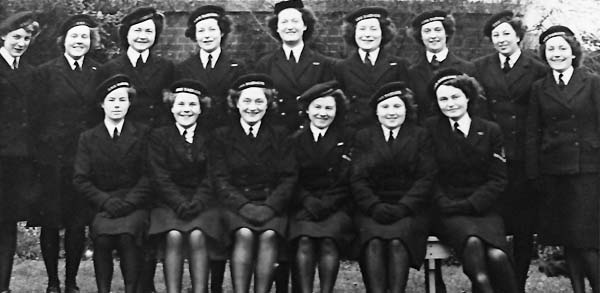
WRNS, HMS Daedalus 1945, Lee-on-Solent (Grace back middle wearing tricorn).
Analysis of Grace’s narrative reveals a number of striking features about her period of service in the Women’s Royal Naval Service (WRNS) at Lee-on-Solent. She felt part of a clearly identifiable group, her uniform distinguished her from the other services and civilians and she felt proud of her part in the war effort. Grace therefore places herself within the dominant narrative of the ‘People’s War’, whereby Britons all had a role to play and wartime citizenship can be interpreted as eroding gender and class barriers.[1]
When compared to the pre and post war period, Grace’s role in the WRNS comprised a memorable part of her life:
A few key areas feature prominently when Grace is remembering her role in a wartime port town. Her uniform, described as “smart” and which she was “proud” to wear and be seen in forged Grace’s physical and individual wartime identity.[3] Her collective identity as part of a group was also important, “the togetherness, the comradeship” meant Grace and her comrades were a “very, very special part of the navy”.[4]
Despite the WRNS not comprising an equal contingent of the navy and not being on the ‘front line’ their separateness, uniform and the other Wrens meant Grace’s period as a wartime ‘Wren’ in a port town was a special moment in her life. Luisa Passerini highlights the importance of assessing individual memory by asserting that the working of the memory is complex, political and idiosyncratic.[5] Therefore individual wartime narratives can offer enriching and commentary insights to aid understandings into analysis of the past.
References
[1] The concept of the ‘People’s War’ and wartime citizenship has been analysed extensively by historians. Refer to: Angus Calder, The People’s War Britain 1939-1945. (London: Pimlico, 2008 [first published 1969, 1992 edition]), 17; James Hinton, Nine Wartime Lives Mass Observation and the Making of the Modern Self. (Oxford: Oxford University Press, 2010), 1; Robert Mackay, Half the Battle: Civilian Morale in Britain during the Second World War. (Manchester: Manchester University Press, 2003), 3; George L. Mosse, “Two World Wars and the Myth of the War Experience,” Journal of Contemporary History 21, no. 4 (1986), 495; Lucy Noakes, War and the British; gender, memory and national identity. (London: I.B. Tauris, 1998), 48; Lucy Noakes, Women in the British Army War and the Gentle Sex, 1907-1948. (London: Routledge, 2006), 103; Sonya Rose, Which People’s War? National Identity and Citizenship in Britain 1939-1945. (Oxford: Oxford University Press, 2003), 1-2.
[2] Interview with Grace, 10 November 2011.
[3] Interview with Grace, 10 November 2011.
[4] Interview with Grace, 10 November 2011.
[5] Ruth Frankenberg, The Social Construction of White Women, Whiteness Race Matters. (London: Routledge, 1993), 42. Source, Luisa Passerini, “Work Ideology and Consensus under Italian Fascism”, History Workshop Journal, no. 8 (1979), 82-108.










Comments are closed.